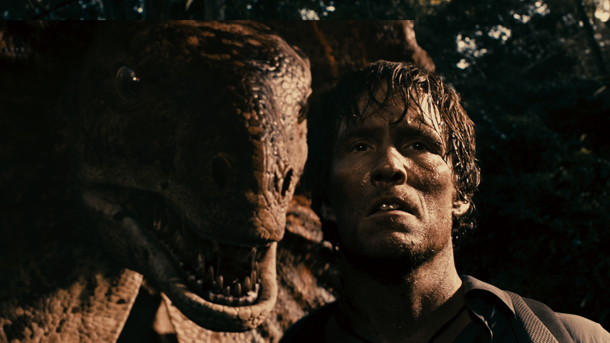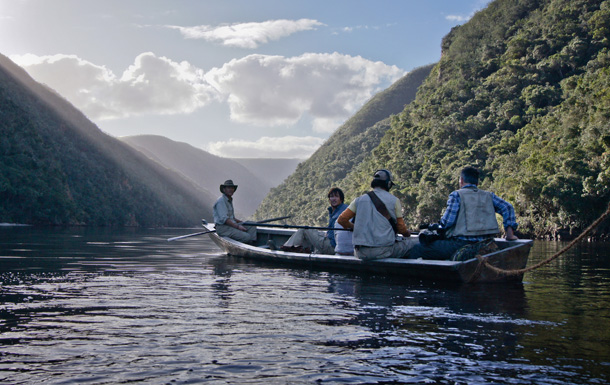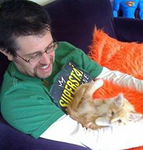The Dinosaur Project: Exclusive Director Interview
It’s the new British mockumentary movie that promises not to skimp on the dinosaurs
The Dinosaur Project director Sid Bennett is pulling a face. I can’t actually see him pulling a face, because I’m interviewing him on the phone. But I know he’s pulling a face…
“I mean people look at me like this…” he says, pausing to pull the face I cannot see, but can guess at, “…and go to me, ‘Oh, it’s found footage.’ But The Dinosaur Project didn’t come from a found footage backdrop. It came from a narrative idea.”
He can’t get away from the fact, though, that The Dinosaur Project is being pitched as – and talked about in the media as – the UK’s first major found footage in years. However, Bennett would rather you thought of this story about a cryptozoological expedition to the Congo to discover the mythical Mokele-mbembe as a fake documentary. And few men on this planet have better credentials for making a fake documentary than Sid Bennett.
His CV includes work on Prehistoric Park , the TV show from the makers of Walking With Dinosaurs that sent real-life naturalist Nigel Marven back to the time of the dinosaurs (“Was that a drama documentary?,” muses Bennett. “A documentary drama? I prefer to call it dinosaur fantasy.”). He also made the mockumentaries Predator X and Mermaid: The Body Found (more of which later). “They are the kinds of things I like doing,” he says. “The, ‘Is it real?’ kind of things. Fantasy. Creatures that people love and actually want to know more about.”

The Dinosaur Project was unashamedly borne of his own love of Cryptozoology and his belief that the work of the CG crews on British shows like Walking With Dinosaurs deserved some big screen exposure.
“Impossible Pictures has done the best dinosaur CG TV programmes in the world,” he enthuses. “It has lead that whole movement. When I was working on Prehistoric Park I did actually have various talks about various kinds of creature type movies. Not TV. Movies. Impossible Pictures has won Emmys and Baftas for its dinosaur programmes. So I thought the next logical step was – how do we get this CGI talent to go from TV onto the big screen?”
But trying to get a British dinosaur movie off the ground had an inherent problem – British film budgets. But Bennett thinks this was actually only a problem in investors’ minds.
Get sneak previews, exclusive competitions and details of special events each month!
“I think a lot of people have been frightened off dinosaur movies because they look at the various Jurassic Park movies and they cost a fortune. So you’ve got these opposing models if you like. You’ve got American Hollywood very expensive dinosaur movies. And you’ve got not-so-expensive TV shows. I mean, things like Walking With Dinosaurs and Prehistoric Park are pretty expensive for TV, but compared to movies they’re in a much lower budget bracket.
“But I thought we must be able to take this talent and put it onto a big screen. I mean, the British film industry cannot match the Hollywood budget, so why don’t we box clever and use our expertise in CGI?”
More of this interview on the next page…
The Dinosaur Project is at selected cinemas from this Friday and out on DVD and Blu-ray on 27 August

But championing the UK’s digital wizards was only part of the origin story.
“I’m really into cryptozoology,” says Bennett. “That a creature that's mythical could be real. The idea for this in particular came a few years ago when I was reading The Sunday Times. There was a story in there about a group of explorers who were a part of some cryptozoological society. It was a real kind of ‘…and finally’ type story.
“They were going off into… it might actually have been the Congo. They might actually have been looking for Mokele-mbembe. And this was a serious expedition, made up of academics, palaeontologists, one or two of them who probably though they were a bit like Indiana Jones, but probably didn’t look much like Indiana Jones.
“And I was making documentaries at the time, and I thought, ‘That would be brilliant documentary to actually be on. To be the director on.’ And then I thought, ‘Hang on. What if they did actually find something? And what if that creature turned out not to be very friendly?’”
So, Bennett argues, The Dinosaur Project didn’t become “found footage” because of any filmmaking trend. The mockumentary format was always part of its DNA.
“It kind of gets labelled as found footage but that wasn’t the first idea. The first idea was a narrative one, which was, if we went on an expedition, with a group of cryptozoologists and they found something, what would then happen?
“If I was out there as a documentary maker, I would have a cameraman and a sound man, and they’d be pretty professional. So most of what you would be seeing would be filmed in a very professional way. It wouldn’t be shaky cam. It wouldn’t be the wobbly cam you associate with found footage. That is the basic premise of the style of The Dinosaur Project . It isn’t all shaky cam. It’s nicely composed. It’s not all claustrophobic. It’s not all in a tiny little space, and all faces close up to camera. It opens out to big vistas of the jungle and valleys. So there is that kind of epic feel to it as well that you wouldn’t normally find with a found footage movie.”

Bennett is clearly keen not be seen as simply jumping on a bandwagon, and to further prove that The Dinosaur Project is the natural evolution of his past work he cites another of his shows.
“I did this thing called Mermaids: The Body Found , which was for Animal Planet and Discovery, that only went out in the States this year,” he says. “ Mermaids: The Body Found looked much more like a documentary, but it was totally drama. We had interviews with scientists but the scientists were actors. It was very much presented as a documentary.
“And if you get a chance to have a look online, Mermaids has been a big hit in the States. It was the biggest Google search term on the evening it went out, because people thought it was real. It was a bit of an Orson Welles moment.”
He’s not wrong. Assuming this might be a bit of justifiable director hyperbole, I Google the show as we talk. I only have to type in “Mermaids” and Google’s second search suggestion after “Mermaids” itself is “ Mermaids: The Body Found ”. Impressive.
“The American Government actually had to put out a statement saying mermaids don’t exist on the back of that programme,” laughs Bennett.
Some sceptics may still think that the found footage format is a way of keeping the movie cheap. Bennett heartily refutes that accusation.
“It’s much harder to do CGI in shaky cam. I think it’s been pointed out by Nick Hill, our producer, that Cloverfield was found footage but that was a very expensive movie. The Dinosaur Project wasn’t made that way to save money. We haven’t skimped.
“If there’s one thing you want in a dinosaur movie, it’s lots of dinosaurs. And I have to say, there’s more minutes of CG dinosaurs on screen than there are in Jurassic Park .”
Lots more dinosaurs on the next page…
The Dinosaur Project is at selected cinemas from this Friday and out on DVD and Blu-ray on 27 August

In fact, he sounds quite excited when I ask him to list some of those dinosaurs.
“I can talk through them. I’ve never actually counted them up. Let’s see…
“The main creature, Crypto, the cute, intelligent dinosaur they meet, he’s a Lesothosaurus. In the real world they found his fossils in Lesotho.
“There’s a kind of bat-like creature that’s evolved from a creature called a Jeholopterus. There is an interesting debate in the paeleontological world, because some people think it could have been a vampire. So I had a think about that one, and said, okay, let’s base it on that creature but let’s have it evolved.’ So it’s much more like a vampire. It’s a real nightmarish creature.
“Then there’s Mokele-mbembe. That’s the creature they go looking for. That’s a plesiosaur. I did a TV movie a couple of years ago, Predator X , but that was a pliosaur. They are related. The pliosaur is a kind of plesiosaur, but the pliosaur is the scary, bitey one, and the plesiosaur is the friendly fish-eating one.
“Then there’s a variety of other creatures which most people will probably know. Pterodactyls, a type of psauropod, which is like a brontosaurus bit we’re not allowed to call them brontosauruses any more. They’re Apatosauruses now.
“What else is in there? There’s actually a T-Rex hiding in there as well. That’s actually a good quiz. Can you spot it?”
A dinosaur Easter egg – now that’s a challenge.
Although set in the Congo, the film was shot in South Africa.
“The closer the equator you get the more you hit jungles,” says Bennett. “But you also have the associated problem the further north you go, the more bitey creatures you get. Crocodiles and things like that. And we did a lot of river work…” he adds ruefully.
“The location backdrop is stunning. There was massive ambition behind this movie. Everybody worked beyond the call of duty to make something special. It was an incredibly efficient shoot as well. We shot a hell of a lot over a relatively short principal photography period. What we were trying to do was maximise the amount of money we had to put the dinosaurs on screen as well. Everything was done to make the movie look bigger and more expensive than it was. We’ve come out with something that punches above its weight I hope. Our CG guys at Jellyfish have done a brilliant job.”
There was another fringe benefit of filming in South Africa for the self-confessed 2000AD fan.
“The South African crew, just before we went there, they’d been filming Dredd . The South African visual FX producer – because I mentioned what a big fan of Judge Dredd I was – he gave me his crew Dredd sweatshirt. I haven’t actually worn it yet, but I think I may just wear it when I go to see the film.”
In fact, Bennett would love to develop a Rogue Trooper film, or something in that vein at the very least.
“I like developing my own ideas and then taking them further. The things I’m developing at the moment are fantasy-based, probably for an older audience. Very CGI again. Thrillers. I love that kind of thing. I’ve got interest on one of these.
“But I’ve been an avid 2000AD reader, from when it first came out… I love that kind of thing. The idea of developing Rogue Trooper as a film… but somebody’s doing that already. I do have a couple of proper SF future ideas bubbling away. But Rogue Trooper, that’s the kind of thing I want to work towards.”
Dave Golder
The Dinosaur Project is at selected cinemas from this Friday and out on DVD and Blu-ray on 27 August

Dave is a TV and film journalist who specializes in the science fiction and fantasy genres. He's written books about film posters and post-apocalypses, alongside writing for SFX Magazine for many years.


